Fire trucks blocking Huron Street, as firefighters enter city hall, emerge again. Reportedly checking out possible odd odor. [photo]
Stories indexed with the term ‘firefighters’
Ann Arbor Fire Department Gets Grant
A federal grant of $87,876 has been accepted for the Ann Arbor fire department through action taken by the city council on May 13, 2013 at a meeting that had started on May 6.
The grant, which comes from the Department of Homeland Security under the auspice of the Assistance to Firefighters grant program (AFGP), is for a specific project for which the local fire department applied. The project involves installation of vehicle exhaust capturing systems – so that diesel fumes don’t accumulate inside the fire stations. The federal grant requires a local match of $21,969 (25%). That local match is being made with money from the city’s general fund.
This brief was filed from the city council’s chambers on the second … [Full Story]
Ann Arbor Firefighters to Get New Gear
Ann Arbor firefighters will be equipped with $150,000 worth of firefighter gear, as the result of city council action taken on May 13, 2013 at a meeting that had started on May 6. The contract authorized by the council is with Phoenix Safety Outfitters.
According to the labor contract between the city and the International Association of Firefighters Local 693, the city is required to provide two sets of turnout gear for each firefighter – in accordance with National Fire Protection Association (NFPA) standards.
According to the staff memo, at least 20 sets of gear are due for scheduled replacement, and 14 more sets of gear are needed in order to equip seven new hires.
This brief was filed from the city council’s … [Full Story]
Transit Withdrawal Before Council Transition
Ann Arbor city council meeting (Nov. 8, 2012): The post-election meeting of the council – moved from its usual Monday slot to Thursday – featured one high-profile piece of business watched by many throughout the county. That was a vote on withdrawal by the city of Ann Arbor from a new transit authority – called The Washtenaw Ride – which was incorporated on Oct. 3, 2012. The vote to opt out was 10-0. Sandi Smith (Ward 1) was absent.
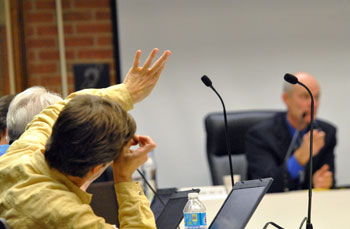
Margie Teall (Ward 4) raises her hand asking to be recognized so she can speak at the Ann Arbor city council’s Nov. 8 meeting. (Photos by the writer.)
Smith had said her farewell from the council at the previous meeting, on Oct. 15. She had decided not to seek re-election to her seat. At the Nov. 8 meeting, two other councilmembers attended their final meeting – Carsten Hohnke (Ward 5) who, like Smith, did not seek re-election, and Tony Derezinski (Ward 2) who did not prevail in his August Democratic primary. New councilmembers – Sumi Kailasapathy (Ward 1), Sally Petersen (Ward 2) and Chuck Warpehoski (Ward 5) – will be ceremonially sworn in at the start of the council’s next meeting on Nov. 19.
A transitional theme emerged, as discussion of some agenda items straddled the Nov. 8 and Nov. 19 meetings – including the transit authority opt-out vote. Stephen Kunselman (Ward 3) had been planning to bring a similar item forward on Nov. 19, when he felt he’d have a six-vote majority on the question. But that move was preempted by the Nov. 8 item, which included the sponsorship of Sabra Briere (Ward 1), Christopher Taylor (Ward 3) and mayor John Hieftje – who had previously been key figures in supporting the city’s role in the planned authority.
Discussion of a living wage waiver for the nonprofit Community Action Network (CAN) also included mention of the Nov. 19 meeting. That’s when a proposal will be brought forward that would change the living wage ordinance itself. The preference of Hieftje and Hohnke to wait and consider the ordinance revision for all nonprofits – instead of granting a waiver to CAN – was strong enough that they voted against the waiver. But the eight votes it received were enough to ensure that for the next three years, CAN does not need to abide by the living wage ordinance – which would otherwise require it to pay all its workers $13.57/hour.
A resolution that transferred $90,000 from the general fund reserve to the affordable housing trust fund was part of the transitional theme – because it had Sandi Smith’s name attached as a sponsor, even though she could not attend the meeting. The dollar amount was keyed to the price of a strip of land belonging to the former YMCA lot, which the Ann Arbor Transportation Authority recently purchased from the city. The transfer of funds was made in the spirit, if not the letter, of a policy enacted by the council at Smith’s urging at her final council meeting. That policy called for net proceeds of the sale of the Y lot to be deposited in the affordable housing trust fund.
The council’s agenda for Nov. 19 was partially previewed when both Briere and Jane Lumm (Ward 2) announced they’d be bringing forward proposals to revise the city’s Percent for Art ordinance – in the wake of a failed public art millage proposal at the polls on Nov. 6. Briere’s proposal would alter the definition of projects that qualify, while Lumm’s would eliminate the program. The Percent for Art ordinance requires that 1% of the budgets for all capital projects be set aside for public art.
And although he’ll be leaving the council, Derezinski will serve out the remainder of Evan Pratt’s term on the city planning commission. Pratt is leaving that role after being elected Washtenaw County water resources commissioner. At the Nov. 8 meeting, council confirmed Derezinski’s planning commission nomination, which had come at the council’s previous meeting. The council also decided to expand a task force on planning for the North Main corridor to make room for outgoing councilmember Sandi Smith, and appointed her to that group as a citizen member. She’s been serving as the council’s representative.
In other business, a resolution that would have moved toward converting the city’s retirement system to a defined contribution plan – instead of a defined benefit plan – was withdrawn. The council also approved increasing the staffing level of the fire department from 85 to 86 firefighters. And the city’s sign board of appeals (SBA) was dissolved by the council, with responsibilities transferred to the zoning board of appeals (ZBA). The council also voted to give city attorney Stephen Postema a 2.4% raise, his first in five years. [Full Story]
Ann Arbor Council Adds One Firefighter
The number of firefighters authorized in the current year’s budget for the city of Ann Arbor nudged upward by one, to 86, as a result of city council action taken at its Nov. 8, 2012 meeting. The position will be funded for the rest of the current fiscal year by tapping the general fund balance reserve for $50,000. For the full year next year, the additional position would cost about $82,000.
According to a memo sent by city administrator Steve Powers to city councilmembers, as the budget planing cycle begins for FY 2014-015, he anticipates being able to maintain the 86 firefighter positions. Part of the rationale for adding the additional position was based on the fact that a recent hiring cycle … [Full Story]
Council Meeting: Floods, Fires, Demolition
Ann Arbor city council meeting (Aug. 9, 2012) Part 2: Ballot initiatives for the Nov. 6, 2012 election – two about parks and one on public art – were the dominant theme of the council’s meeting. Those are covered in Part 1 of the meeting report.
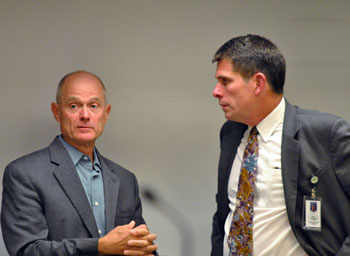
From left: Mayor John Hieftje and city administrator Steve Powers before the start of the Aug. 9, 2012 council meeting.
But the council transacted several other pieces of business as well, some of which could be grouped into the general thematic pattern of land and property use. Most obviously connected to land use was the council’s initial approval of a rezoning request in connection with an expansion proposal from Knight’s Market, at the corner of Miller and Spring streets. The rezoning would allow a house to be converted into a bakery. It would also allow for eventual approval of a site plan to build a 1,200-square-foot addition to the existing grocery store and to expand, reconfigure, and improve the existing parking lot.
The council also passed a resolution to deal with an issue stemming, in part, from land use decisions made decades ago that resulted in residential development in the area of the Malletts Creek drainage district. Recently, residents in the area have been faced with severe localized flooding. The council’s resolution directed staff to start negotiations with the Washtenaw County water resources commissioner to identify “opportunities for stormwater conveyance and stormwater quality improvement in the area of the Malletts Creek drainage district.”
Related at least tangentially to land use at the level of a specific parcel was a resolution the council passed establishing the property at 317 Maynard in downtown Ann Arbor as an industrial development district. The move sets the stage for an expected application from the future tenant of the space, owned by First Martin Corp., for a tax abatement that would be worth around $85,000. The tenant is Barracuda Networks.
And the council took another step in implementing a strategy to eliminate blight. The city had previously set aside funds that could be used to demolish blighted buildings – if the city is unsuccessful in getting property owners to demolish them. The council’s action last Thursday authorized the city to sign contracts with four different companies to do such demolition work on an as-needed basis. It was announced at the meeting that the houses on North Main – at the site of the planned Near North affordable housing project – will likely be among the first to be demolished under the contracts authorized by the council.
To the extent that transportation systems have an impact on future land use, another item related to land use was a reapproval of the articles of incorporation for a possible new countywide transportation authority. The articles of incorporation are part of a four-party agreement to establish a framework for possibly expanding the governance and service area of the Ann Arbor Transportation Authority.
The four-party agreement is between the cities of Ann Arbor and Ypsilanti, Washtenaw County and the AATA. The Ann Arbor council changed the minimum threshold of votes required on the proposed new 15-member transit authority board, an action that brought the council in line with a version that the Washtenaw County board of commissioners had approved earlier this month. That threshold was increased from a 2/3 majority (10 votes) to a 4/5 majority (12 votes).
In other business, the council authorized the hiring of three additional firefighters for the next two years, using a federal grant. It also authorized the purchase of a new aerial fire truck.
Nominations to city boards and commissions made at the meeting included reappointment of Sandi Smith, Roger Hewitt and Keith Orr to the board of the Ann Arbor Downtown Development Authority. And Sally Petersen, who won the Ward 2 Democratic primary on Aug. 7, was nominated for the city’s commission on disability issues.
The council also heard public commentary on a range of topics, including smart meters and the idea of corporations as people. [Full Story]
Local Firefighter Finishes Executive Program
A brief ceremony in the lobby of city hall on June 18, 2012 recognized Ann Arbor firefighter Lt. Amy Brow for completion of the U.S. Fire Administration’s Executive Fire Officer Program. [photo 1] [photo 2]
It’s a program that takes four years to finish – with one 10-day course completed each year at the Emmitsburg, Maryland campus. The curriculum includes: (1) executive development; (2) executive analysis of community risk reduction; (3) executive analysis of fire service operations in emergency management; and (3) executive leadership. Each year requires the completion of an applied research project.
Brow’s applied research project for 2010 was an analysis of fire risk caused by upholstered furniture placed on porches. The 48-page report was entitled: “… [Full Story]
Ann Arbor Receives Firefighter Grant
In a press release issued on May 30, 2012, Michigan’s U.S. Senators Debbie Stabenow and Carl Levin announced the award of a $642,294 federal grant to the city of Ann Arbor to hire new firefighters. The grant comes through the Staffing for Adequate Fire and Emergency Response (SAFER) program. How that money translates to firefighter positions is not yet completely clear.
Reached by email, city administrator Steve Powers indicated that the city’s application had been for three firefighter positions for what he believed to be two-year grant period. Ann Arbor’s unit cost for a firefighter full-time equivalent is $79,599 per FTE. For a two-year grant period, that would translate to almost exactly four firefighters for each of two … [Full Story]
Debate Details: Ann Arbor FY 2013 Budget
Ann Arbor city council meeting (May 21, 2012) Part 2: The council approved the city’s fiscal year 2013 budget – with disagreement about what priorities it reflected.
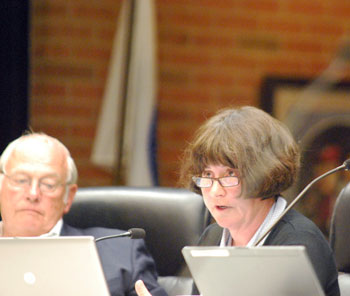
Tony Derezinski (Ward 2) looks on as Jane Lumm (Ward 2) pleads her case for increased police staffing levels. Though Derezinski had little sympathy for Lumm’s amendment on police officers, he joined her in supporting a budget amendment to restore collection of loose leaves in the fall as a city service. The city now collects leaves and compost in containers instead of allowing residents to sweep piles of leaves into the street. The amendment failed. (Photos by the writer.)
The cumulative impact of the amendments approved by the council on May 21 increased general fund expenditures to $79,070,842 against revenues of $79,193,112, for a surplus of $122,270. The entire city budget, across all funds, was proposed at $404,900,312 in revenues against $382,172,603 in expenses. The fiscal year begins on July 1.
Jane Lumm (Ward 2) saw two of her proposed amendments fail – which would have funded five additional police officers from non-specific reductions in other general fund departments, and would have restored the service of loose leaf collection in the fall. She also opposed the addition of a court secretary position for the 15th District Court, which the rest of her colleagues agreed to add into the budget that evening. That combination prompted her to vote against the overall budget, saying it did not adequately prioritize public safety. She was joined by Mike Anglin (Ward 5) in voting against the budget.
But Mayor John Hieftje summarized the majority view on the council in framing this year’s budget as a reflection of public safety as a top priority of the city – because nearly half of the general fund is being spent on public safety, and the vast bulk of additional revenue for FY 2013 (compared to the forecast in last year’s budget planning) is being spent on public safety. Those investments in public safety prevented further reduction in budgeted firefighters (by five) and in police officers (by nine) – reductions that were originally called for in the two-year budget plan. Those investments also allowed the city to add one police officer.
However, former police chief Barnett Jones and current fire chief Chuck Hubbard have identified ideal targets for staffing levels for their departments that are higher than the budgeted levels for FY 2013. For the fire department, that’s 82 firefighters compared to Hubbard’s ideal 88; for police, that’s 119 sworn officers compared to Jones’ ideal 150. The point of disagreement on the council essentially reduced to this: Should the city take additional steps this year to reduce the gap in public safety staffing between current levels and the ideal targets?
One resolution approved at the meeting – which did not actually modify the budget – simply directed the city administrator to bring a future mid-year budget amendment to add up to six firefighters to the budget – if a federal grant and increased state fire protection allocations materialize. Although it would have been conceivable to pass a parallel resolution on the police side of public safety, there was no effort at the table (by Lumm or other councilmembers) to modify Lumm’s resolution and stipulate that additional police officers would be hired, if a federal grant application were successful.
Voting for the budget were eight councilmembers, including Stephen Kunselman (Ward 3), who saw two of his own amendments fail. One would have interpreted the city ordinance on DDA TIF capture differently, which would have resulted in additional revenue to the city’s general fund – revenue sufficient to fund two firefighter positions. Also failing was an amendment that would have prevented the transfer of money to the public art fund from a variety of different sources. [The 8-2 overall budget vote on the 11-member council was due to the absence of Marcia Higgins (Ward 4) for the final vote. She attended the meeting and stayed for the better part of it, but succumbed to a persistent hacking cough before it ended.]
Although several amendments failed, others were approved by the council. Those included budget modifications that added a secretary position to the 15th District Court, increased human services funding by $46,899, added $78,000 to the Ann Arbor Housing Commission budget, and eliminated a contract with RecycleBank to administer a coupon program to encourage recycling.
The council’s budget discussion came in the context of a briefing from the city’s paid lobbyist in Lansing, Kirk Profit, who sketched an uncertain state budget picture, but offered compliments to the city’s approach to managing its budget.
Box-score style results on the budget amendments were previously covered in a report filed from the city council chambers on the night of the vote. Below we’ve summarized the deliberations by the council on the budget amendments. Items not related to the FY 2013 budget are detailed in Part 1 of this meeting report: “City Council Expands North Main Task Force.” [Full Story]
Fire, Police Retirement/Health Changes OK’d
At its April 16, 2012 meeting, the Ann Arbor city council gave approval to changes to the employee retirement system to accommodate recent changes to the collective bargaining agreement with its police command officers union and firefighters union. The council also gave final approval to changes to the retirement health care benefits to reflect changes to those collectively bargained agreements.
Changes to the retirement system include: (1) increasing the pension contribution of command officer members to 6% from 5%; (2) implementing a pick-up feature as permitted by the Internal Revenue Code for the pension contributions of firefighters and command officers, converting their 6% pre-tax contribution to a 6% post-tax contribution; (3) increasing the vesting and final average compensation requirements for firefighters hired … [Full Story]
Budget Round 2: What’s the Big Idea?
On Monday night, the Ann Arbor City Council continued with the second in a series of extra meetings devoted exclusively to budget issues. Much of the discussion was a review of information that councilmembers had deliberated at their Jan. 25 meeting, when the focus was specifically on the community services area.
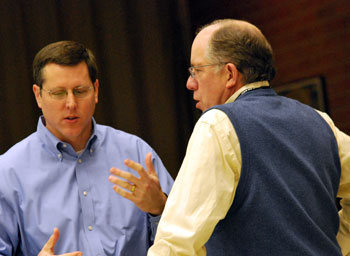
At left is Tom Crawford, the city's CFO. To the right is Roger Fraser, city administrator. (Photos by the writer.)
The community services area comprises the Ann Arbor Housing Commission, planning and development, human services, and parks/recreation. The council had chosen to focus on that area first, because of the community service area administrator’s imminent departure – Jayne Miller’s last day working for the city is Feb. 12, 2010.
But Miller’s new post as director of the Huron Clinton Metro Authority (HCMA) factored into some of the conversation on Monday, ranging from HCMA’s canoe rental fee structure, to the (remote) possibility that HCMA might take over some of the city of Ann Arbor’s parks. It was those larger scope issues the council was meant to address on Monday.
So at Monday’s meeting, city administrator Roger Fraser labeled the occasion as a time to talk about the “big ideas” the council had been presented at their December 2009 budget retreat. And councilmembers did eventually come around to start grinding through the list of ideas.
Rather than organize our account of the meeting based on that list, we’ve identified some themes that might provide an alternate framing of some of the budget challenges. We’ve formulated them as questions: (i) What are the basic philosophies? (ii) Should anything be held harmless? (iii) What do we do with our land? (iv) Is increasing revenue an option? [Full Story]
Council OKs Firefighter Deal, 911 Center
Ann Arbor City Council meeting (Jan. 19, 2010): The Ann Arbor city council approved an agreement with the local firefighters union that reduces pay by 3% to ensure that no firefighters will be laid off before June 30, 2010.
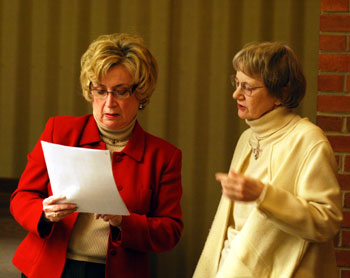
State Rep. Pam Byrnes, left, and Karen Sidney talk before the start of the city council's meeting, which included a presentation at the start of the meeting from Byrnes. (Photos by the writer.)
And, in a move that some councilmembers described as leadership, mayor John Hieftje announced that he was writing a check for $1,273 as a contribution back to the city, because that’s the equivalent of 3% of his annual salary – the same percentage conceded by the firefighters union. It’s also the same percentage Hieftje has suggested that all employees citywide accept as a wage reduction. Some councilmembers indicated they’d be making similar gestures, which they allowed were only symbolic.
The city council also approved a budget increase for the 911 call center modification, a project to facilitate co-location of the city and county 911 centers – it’s expected to be a cost-savings measure.
Council also directed the city administrator, Roger Fraser, to plan an event to honor volunteer members of various boards, commissions and committees that do much of the work required to make the city run.
In other business, the council approved without discussion a University of Michigan project for the soccer complex on South Main Street.
State Rep. Pam Byrnes (D-District 52) gave a presentation to the council at the start of the meeting outlining exactly how bleak the economic outlook is in Michigan.
Many of the items on council’s agenda were postponed: revisions to bicycling and pedestrian ordinances (including bicycle registration); revisions to parking fines; and the capital improvements plan.
And two of the items were pulled from the agenda at the start of the meeting: a revision to the ordinance on signs and outdoor advertising to allow portable signs; and a resolution to approve the transfer of a liquor license to BW&R GoBlue LLC, located at 640 Packard Street. [Full Story]
Budget Crunch Backdrop Drives Council
Ann Arbor City Council meeting (Dec. 21, 2009) Part II: In Part I of our report, we handled two meeting topics clearly related to the looming budget shortfall: public art expenditures and parking revenue.
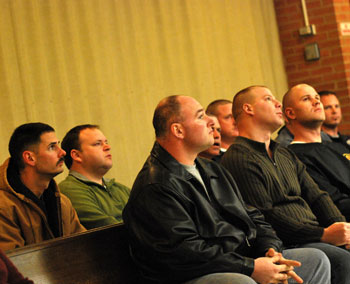
Members of International Association of Firefighters Local 693 waited past midnight until their president finally was able to take his turn at public commentary during unreserved time at the end of the meeting. (Photo by the writer.)
Two rows of firefighters from the International Association of Firefighters Local 693 – layoff notices have already been sent to some of them – sat in the audience through the whole meeting, which lasted until midnight.
Like the firefighters, sitting at least in the background of nearly every item on the agenda, were the looming budget issues that the city council faces.
When they came to the foreground, the concerns about the budget managed to connect topics as seemingly disparate as Verizon antennae and parking revenues.
Even a garden-variety contract with a consultant for the greenbelt provoked some brief discussion related to the budget shortfall.
The impetus behind the council’s committee reorganization was again … the budget. What was previously one budget and labor committee was split into two committees: (i) the budget committee, and (ii) the labor committee, which is now combined with the council administration committee. That reorganization was pitched as a way to allow representation from each ward on the five-member budget committee.
Councilmembers and the city administrator also made robust use of the communications section of the agenda to provide status updates on their recent work – much of it related to efforts to identify new revenue streams and ways to cut expenses as part of the effort to meet budget goals.
In other business, the purchase of carts for single-stream recycling was authorized, plus an energy grant totaling over $1 million was accepted. [Full Story]
River Report Remanded, Art Rate Reduced
Ann Arbor City Council meeting (Dec. 7, 2009) Part I: Based on dialog at the city council’s budget retreat on Saturday, and the absence of any action at Monday’s council meeting to prevent it, layoff notices to 14 firefighters will be sent sometime this week.
Mayor John Hieftje also gave some additional detail on a proposal he’d mentioned at the council’s budget retreat on Saturday: an across-the-board wage cut of 3% for all city employees, which would include councilmembers.
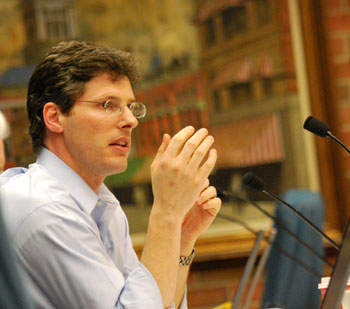
Carsten Hohnke (Ward 5) presents his case for having a plan for the Huron River. (Photos by the writer)
Though the topics of firefighters and wage cuts were mentioned during the council’s communications section of the meeting, what pushed the meeting to nearly midnight were deliberations on two resolutions: (i) a three-year reduction of the Percent for Art program to effectively a “Half-Percent for Art” program, and (ii) acceptance of the Huron River and Impoundment Management Plan (HRIMP).
Both resolutions passed, though the HRIMP resolution was heavily amended. The material effect of the amendment was that it was not technically “accepted” by the council, but rather remanded to the city’s park advisory commission and the environmental commission. [Full Story]
Ann Arbor City Budget: Cuts Begin Now
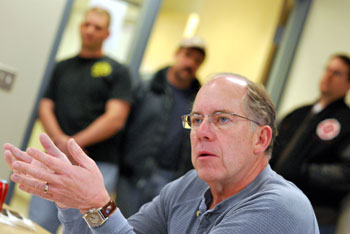
Ann Arbor city administrator Roger Fraser talks with city councilmembers about upcoming budget decisions. That possibility includes layoff notices to 14 firefighters to be sent as soon as the week of Dec. 7. Members of the International Association of Firefighters Local 693 stand in the background. (Photos by the writer.)
Unless he receives other direction from the Ann Arbor city council at its Dec. 7 meeting, city administrator Roger Fraser told councilmembers at their Saturday budget retreat that he’ll begin implementing a plan to trim around $3 million out of the current fiscal year budget.
The moves are necessary to balance the FY 2010 budget, which ends June 30, 2010.
Some of that trimming is a matter of accounting for one-time savings – $500,000 had been budgeted for the Pfizer tax refund, but was settled last year so won’t be on the books for FY 2010. Other trimming is a matter of accepting current situations and committing to them going forward, for recurring savings – for example, vacancies from excess reductions of police through the early-out retirement incentive would not be filled.
But some of the trimming would entail cutting positions currently filled – 14 firefighter positions, which account for around $400,000 of the $3 million to be saved in FY 2010. The move to eliminate firefighter jobs had been part of the FY 2011 plan, but would be implemented six months earlier – now.
For FY 2011, the picture gets even worse, with the city facing a $5.4 million shortfall. And looking ahead one year after that, city council will be faced with constructing a budget for FY 2012 that is 30% smaller than the one they approved for FY 2009. [Full Story]
Regents Get Update on Town-Gown Relations

Matt Schroeder, president of the Ann Arbor firefighters Local 693, spoke to UM regents at their Sept. 17 board meeting about how possible firefighter layoffs could affect campus safety. (Photo by the writer.)
University of Michigan Board of Regents (Sept. 17, 2009): UM regents heard two presentations at their Thursday board meeting that closely linked the university and the community of Ann Arbor. Jim Kosteva, UM director of community relations, gave an update on the ways that the university is involved with the city, including payments as well as partnerships. And Matt Schroeder, president of the Ann Arbor firefighters Local 693, spoke during public comment on the possibility of additional layoffs among city firefighters and the potential impact it would have on the university.
Regents also heard several other reports and updates: from the director of the Life Sciences Institute; an architect working on the new basketball practice facility at Crisler Arena; and two alumni who hope to get the university more involved in an effort called Patriot Week.
And during her report on the board’s personnel, compensation and governance committee, regent Andrea Fischer Newman said that UM president Mary Sue Coleman had requested – and the committee agreed – not to raise Coleman’s salary this year.
We’ll begin with the issues most directly related to the Ann Arbor community: Kosteva’s report, and Schroeder’s public commentary. [Full Story]
Ann Arbor City Council Gets Budget Preview
At Monday night’s city council working session, city administrator Roger Fraser introduced a recommended budget for fiscal year 2010 (beginning July 2009) of about $85 million, down from the almost $91 million budget in FY 2009. Declining revenues from property taxes, together with increasing contributions to the pension fund means that for FY 2010, the equivalent of 34 full-time positions at the city would be eliminated, followed by 22 full-time positions in FY 2011. If implemented, the cuts would reduce the city workforce from 800 to 746 by 2011 – a number that has declined from a peak of 1,005 city workers in 2001.
A range of other recommendations include closing Mack pool for the summer, eliminating funding for the civic band and Project Grow, and increasing the water utility’s safety services fee by 4%.
The timeline for the budget’s adoption will include an April 14 town hall meeting at 7 p.m. at the CTN studios on South Industrial. That will be followed by public hearings on May 4, with council adopting a budget with any amendments on May 18. If council fails to act on the budget or to amend it by its second meeting in May, then per the city charter, the budget as submitted by the city administrator is automatically adopted.
The park advisory commission will hold a public hearing next Tuesday, April 21, on the recommendations related to parks, before voting on its recommendation. [Full Story]



